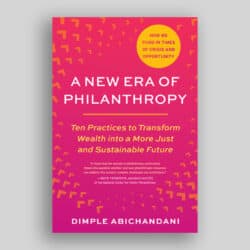Adam Kahane’s new book – a “manifesto for world-changers” – aims to liberate systems thinking where the rubber hits the pavement: in real-world, real-life contexts, by cultivating seven potent habits.
Everyday Habits for Transforming Systems: The Catalytic Power of Radical Engagement, by Adam Kahane. Berrett-Koehler Publishers, 2025; 200 pages; ISBN 9781523006861.
Recent years have seen an intensifying focus on “systems philanthropy,” a form of philanthropy that seeks to address complex social problems by understanding and changing the underlying systems that perpetuate them. To change the status quo, we need to recognize, as a minimum requirement, that we are suspended in webs of significance that we ourselves have spun, to paraphrase the 19th-century sociologist Max Weber. This contrasts with the more historic focus of philanthropy as relieving the symptoms, or investing in other shallower, less durable outcomes.
Indeed, systems are everywhere, from the quantum scale to the cosmic. Moreover, the complexity of systems appears to rise dramatically in the middle point between the very large and the very small, a place that happens to be where we exist: the realm of human beings, and the biosphere that sustains us. This is why human problems – including every cultural, economic, environmental, familial, financial, health, political, and social problem we can list – are complex enough to require a systems perspective. Non-linear, holistic, non-deterministic, pluralistic, and multifaceted. A systems perspective, in turn, requires us to realize that everything is in relation. Not as a metaphor, but as an integral feature of reality. It is the interconnections and interactions that matter. The verbs more than the nouns.
But most of us working from a reductionist Western frame of mind, and schooled in Western industrial ways of learning, don’t have the depth or breadth of knowledge, skills, or everyday practice to embrace “a systems way of working.” Not at the scale that is required to tackle economic, environmental, political, or other human challenges. Systems literacy is in far too short a supply – whether in the academy, in the boardroom, in the operating room, on the shop floor, in spaces of care, or even in everyday human interaction; in the very way we engage with one another, be it as family, friends, neighbours, colleagues, or comrades.
Into this competency breach steps Adam Kahane’s Everyday Habits for Transforming Systems: The Catalytic Power of Radical Engagement. Described as a “manifesto for world-changers,” the book “aims to enable ordinary citizens to become extraordinary agents of transformation.” This volume is part of a small but growing body of literature that aims to liberate systems thinking from the rarefied world of systems scientists and complexity theorists, applying the concepts, mindsets, frameworks, and skill sets where the rubber hits the pavement: to real-world, real-life contexts and scenarios. Whether Kahane intends this or not, it is part of an implicit and nascent movement to democratize systems practice. And a welcome addition it is.
In this existential moment for Canadian identity, it is worth reflecting on what Kahane’s approach represents: the best of what Canada historically pictured its role as, writ large on the world stage – exercising soft power (the power of open communications and adroit diplomacy), brokering conversations between powerful interests who are deeply suspicious of each other, and providing a template for people to collectively envision positive, peaceful futures.
Kahane has been involved in helping government, business, and community leaders navigate some of the world’s most complex and high-stakes problems.
An experienced facilitator, scenario planner, and conflict mediator, Kahane has been involved in helping government, business, and community leaders navigate some of the world’s most complex and high-stakes problems. He has facilitated dialogues in societies riven with conflict, including Colombia, Guatemala, Myanmar, and in a reconciliation context within Canada. He was a key figure in the Mont Fleur exercise, an early-1990s scenario-planning and foresight process that helped key players on both sides of South Africa’s apartheid divide work through their deep conflict and make sense of their historic opportunity (uncertain at the time, but decisive in hindsight). Such a process of working together to imagine shared futures was unthinkable in a country where just a few years prior, hope seemed in desperately short supply.
It’s these big, messy, seemingly hopeless conflicts and crises that Kahane is drawn to, partly because he knows that every shadow has light; every problem is an opportunity. As he notes in his preface to the new book, “we can see that these crises (and the attendant fear, anger, polarization, and violence) are creating both breakdowns and breakthroughs – but we don’t know what we can do to attenuate the former and amplify the latter.” The book demonstrates convincingly that a systems approach, deeply interpreted and practised, is inherently de-polarizing.
The book demonstrates convincingly that a systems approach, deeply interpreted and practised, is inherently de-polarizing.
Kahane parlayed his early work into a broader interest in transformative social change, bringing scenario planning from corporate board retreats into grassroots settings. He co-founded Reos Partners, a global company that aims to “help people work together across differences to achieve systems change.” His 2010 book Power and Love is a practical rumination on Martin Luther King’s observation that “power without love is reckless and abusive, and love without power is sentimental and anemic,” a theme he returns to in this book. Kahane argued in that earlier work that most efforts at transformation fail because they lean either too heavily on power (causing domination and division) or too much on love (resulting in passivity or ineffectiveness). Here he revisits the requirements for transformation, exploring a more nuanced terrain of engagement between these poles of power and love.
Everyday Habits for Transforming Systems is Kahane’s sixth book. At a slight 200 pages, it is a lean and efficient encapsulation of some big ideas and concepts. Even for a slow reader like me, it can be dispatched in a matter of hours. It serves as a straightforward counterpoint to what so many others – myself included – can take a long time explaining. What’s common sense isn’t common practice, to paraphrase Voltaire. Likewise, what’s common practice is rarely commonly phrased. It can take many writers a long time, deploying a decorative but frequently alienating systems dialect, to get around to the essential takeaways. This work, however, is refreshingly straight to the point. It’s more pep talk than fastidious opus.
In an approachable, conversational tone, the book urges the reader to cultivate seven habits, tessellated into a flower-shaped series of seven hexagons for easy recall:
1. Acting responsibly
2. Relating in three dimensions
3. Looking for what’s unseen
4. Working with cracks
5. Experimenting a way forward
6. Collaborating with unlike others
7. Persevering and relaxing
Each habit has its own pithy chapter, coloured with personal recollections from extraordinary changemakers, beginning with three particularly powerful stories of those who have worked on massive-scale systems transformation: transitioning from racial segregation in South Africa, peacemaking in post-civil-war Colombia, and coalescing global action on anthropogenic climate change. A risk in framing the book this way is making the stories of these three celebrated changemakers unrelatable. But Kahane deftly closes this chasm, a testament to his work at both international policy tables and in grassroots community settings across Canada.
The tone is humble and reflective throughout, almost confessional, with a particularly self-deprecating story of his early days as a futurist working for Shell, thrown into the ripened conflict of apartheid South Africa. He is careful to use the term “contributing to” to qualify anyone’s role in shifting systems. The many changemakers who have interacted with Kahane are not heroic protagonists, but subtle conveners, superb listeners, and ceaseless crafters of questions.
Kahane stresses how vital it is to understand the experience of those who have been harmed by the system as it currently is.
He covers off the core mindsets and “heartsets” that one might access: pathways to knowledge and ultimately toward breakthroughs – curiosity, openness, appreciation/respect, and humility among these. He stresses how vital it is to understand the experience of those who have been harmed by the system as it currently is. And if we are really interested in change, it requires change in ourselves. It requires a more fully rounded and more deeply human form of engagement – even seeing the other as “kin.” These habits constitute a “radical” approach (by which Kahane means “radical” as foundational, or root-layer, not the extremist sense of the word). He observes how changemakers use metaphors like “carving,” “weaving,” or “sailing,” working with the natural material of the system to bring out its latent potential, rather than imposing something externally.
Most writers on systems topics, post-Donella Meadows, tend to use the US environmental scientist and systems researcher’s notion of “leverage points” to describe places with potential to intervene in a system. Kahane instead uses the (likely more apt) metaphor of cracks, based on Leonard Cohen’s observation from his 1992 song “Anthem”: “There is a crack, a crack in everything. That’s how the light gets in.” He follows this up with a section on small experiments, observing that the context of complexity benefits more from trying stuff out than it does from planning and strategizing.
He observes that the context of complexity benefits more from trying stuff out than it does from planning and strategizing.
There is some familiar ground trodden here, such as anecdotes from the story, journey, and characters involved in a social innovation narrative that emerged under the banner of (or adjacent to) SiG (“social innovation generation”) in the earlier part of this century. The book also includes numerous illustrations and asides that speak to ecological equivalents for each habit, which fail to land completely. While I appreciate the intent of underscoring how systems challenges in the human world typically have analogues in the non-human world, these feel like an afterthought and don’t offer much new insight. But these are minor quibbles in a work that is rich with wisdom and informed by considerable experience and insight – both of Kahane’s and of the fascinating people he quotes extensively. These are people who set the bar for what it means to have a full and purposeful life, even as their giant contributions can seem incremental in a world that too often feels hell-bent on the descent of our species.
Kahane is also part of a growing chorus of writers and reflective practitioners who are asking us – not as leaders or influencers, but as everyday people – to look at ourselves as systems, and as agents with real power within broader systems we can feel overwhelmed by. He mentions the developmental leadership guru Bill Torbert, who plays on the aphorism “If you aren’t part of the solution, you are part of the problem” by pointing out that you actually can’t be part of the solution if you are not part of the problem. In explaining one of the seven habits – relating with people in three dimensions – Kahane caricatures individuals who tend to be locked into one dimension. I’m sure most of us can recognize ourselves in one of these: “1) the whole systems designer or policy wonk who treats politics as unfortunate and humanness as unimportant; 2) the power broker or deal maker who treats systems design as impractical and relationships as irrelevant; and 3) the community builder or tree hugger who treats systems design as ungrounded and self-interest as misguided.”
In reading this, I was challenged to reflect on the nature of my engagements with others. The understanding of systems – which is the subject of my upcoming book, The 55 Minutes – is vital. But how we interact at a human level with these human systems is just as vital. Are these interactions shallow or deep? Authentic or veneer? Responsible or cavalier? Brave or comfortable? Exploratory or frozen? Imaginative or prosaic?
Kahane extends and enriches his notion of engagement, a concept he calls ‘stretch collaboration,’ drawing from the Indigenous recognition that we are all related.
Of his five previous books, Kahane’s 2017 work Collaborating with the Enemy: How to Work with People You Don’t Agree With or Like or Trust is perhaps his most useful and prescient. It should be required reading for anyone working in a context of public problem solving, where people disagree not just on solutions, but on the very nature of the problem, and even on whether there is a problem to be concerned about at all. Where people think the other side is so out of touch with reality that they might even feel a sense of loathing being in their presence. This is where Kahane first invoked the concept of “stretch collaboration,” where true progress in hyper-polarized environments comes from the power of engaging. Engaging at a much more meaningful level than at the transactional level we typically default to in public settings. In Everyday Habits for Transforming Systems, he extends and enriches this notion of engagement, drawing from the Indigenous recognition that we are all related. Every person, every living being, every aspect of the cosmos is in relationship, and this means something vitally important for how we transform systems.
“Acting responsibly is less a recipe than a riddle.” This is one of many memorable turns of phrase that pepper the book. “Transformation requires pragmatism rather than purity” is another. Add to this the behind-the-scenes storytelling here from people who have made this world a kinder, more beautiful, more resilient place to live, and I am reminded of fantasy writer Philip Pullman’s reflection: “‘Thou shalt not’ might reach the head but it takes ‘Once upon a time’ to reach the heart.” There’s even a welcome discussion guide, to help frame storytelling in (I imagine) classrooms, book clubs, and team retreats.
We live in interesting times, but this book is a reminder that we’ve always lived in interesting times, no less fraught with peril, conflict, and the sense that there is no way forward . . . until there is. When so many other books strike an earnest, doomsaying tone, the tenor of this book feels more like a comforting blanket or a warm tonic. And yet, its implications are anything but. As Kahane reminds us, “Radical engagement is rarely serene, straightforward, or safe.”
James Stauch’s book The 55 Minutes: An Atlas to Navigate Problems, Reveal Systems, and Ask Beautiful Questions in a Radically Shifting World will be published in May.


